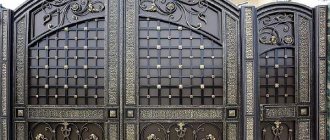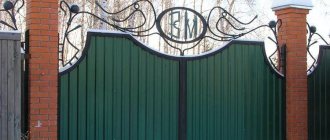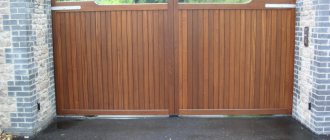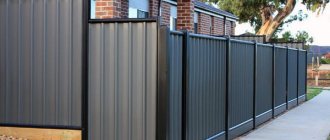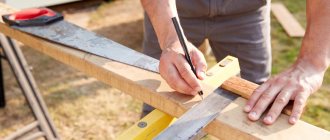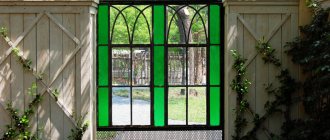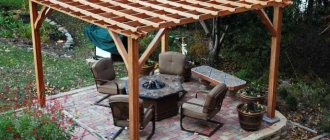At a dacha, in a country estate, the owners of which have a car, arrangement of the entrance part of the yard is a necessity. Therefore, the fence is always made with a gate. Usually, the entire fence is installed by specialists, but if desired, the owners can make the gates and other elements of the fence with their own hands. This will take more time, but will reduce construction costs.
Types of gates
There are several types of gates based on their design features and methods of opening. Let's look at the nuances of each of them in more detail.
Users often search for:
- Photo of a gate for a private house
- Wooden gate options
Sliding (sliding)
The principle of operation is to move the sash on rollers along a guide profile along the fence.
Sliding gates are available in three versions:
- Hanging. Rarely used in summer cottages and in the private sector. The reason for this is the limitation of the passage height by the upper metal profile to which the sash is mounted. When opened, the door rises up.
- Recoil. The canvas moves along a rail that runs below along the entire wall. For the northern regions of the country with frequent frosts and snowfalls, it is not recommended to use such a design, since the rail will have to be constantly cleaned.
- Console. For retractable types of gates, console ones are considered the most practical. They have a complex design. The canvas is securely fixed to the beam, which during operation moves the sash along the cantilever assembly. A huge plus is that the canvas does not touch the ground when moving.
The downside is that you need to clean the guide profile from debris and ice, which become an obstacle to the movement of the sashes.
However, equipping with an automatic control system allows you to control the operation of the valves remotely. This significantly saves time and increases operating comfort. Especially in bad weather, when the owner does not need to get out of the car to open the door.
The requirement for automatic operation is the presence of electricity.
Tilt&Turn
They are used in the construction of garages and other buildings inside the yard.
They are not suitable as fence gates because they significantly limit the height of a car's entry.
When opened, the canvas rises up and moves close to the ceiling using a rotating mechanism.
Rolled
This design is new to the construction market. Consists of many steel strips assembled into one flexible sheet. When opened, the canvas begins to roll up and wrap around a special shaft. This allows the car to drive close to the doors of a fence or garage.
Folding (accordion)
Sectional doors. Available with two opening methods: sideways and up. The last option is the most popular.
Swing
This is an excellent option for homemade gates. They are most in demand in the private sector due to their ease of assembly and the ability to use cheap materials.
They can be either part of a temporary or permanent fence.
Consist of two halves.
For installation near the roadway, they are mounted so that the doors open into the courtyard area. In street conditions, this means saving free space and unhindered movement of pedestrians along the sidewalk.
Article on the topic: “Making swing gates from profile sheets.”
Below we will analyze the aspects of self-construction of this type of sashes.
Location Features
If the construction of a cottage or house is only at the development stage, then you need to select the optimal location for the gate structure. Initially, you need to determine whether the gate will make it difficult for cars to enter from other areas, or whether it will block traffic if it is located next to the roadway.
Sliding sash
It is not recommended to install gates for entering a private house, the doors of which open to the street. This may interfere with other road users.
Frame making
First, you need to calculate the dimensions, correctly draw a drawing with the placement of the smallest parts, make several sketches from different angles, and only after accurately calculating the amount of required materials and total costs, start assembling the frame.
When determining the height of the future gate, it is important to leave gaps below the ground level of 5 to 10 cm. If tiles or asphalt are laid on the site, then the gaps can be reduced to 5 cm. If there is no covering (if grass grows there), the gaps should be left larger.
The frame can be made of wood or metal. Due to their limited service life, wooden elements are most often used as decoration or for a temporary fence.
For a permanent and durable fence, it is better to use metal. The frame is assembled from it using welding.
Diagram of a frame for a gate made of a profile pipe
To obtain a frame, you need to prepare profile pipes in the following quantities and sizes:
- 22 m of corrugated pipe with a cross section of 60*40 mm will be needed for the main parts and jumpers. The elements will be welded to the pillars and are responsible for holding the entire structure.
- 15 m of corrugated pipe with a cross section of 40*20 mm - to strengthen the frame. The sash trim is attached to them.
The thickness of the metal should be at least 1.5–2 mm. For beginners in welding, it is better to take sheets with walls of 3 mm.
is when purchasing frame material .
For large-sized products, we recommend taking into account the following points:
- With a leaf weight of up to 150 kg, a pipe with a cross-section of 80*80 mm and a thickness of 4 mm is sufficient.
- In the range from 150 to 300 kg, a reinforced version is taken with a section of 100 * 100 mm, with a wall thickness of 5 mm.
- For malleable and other heavy products weighing over 300 kg, you need to take iron pipes with a cross-section of 140 * 140 mm, 5 mm thick.
The correct procedure for assembling the frame is described above in the article about swing gates made of corrugated sheets.
Together with the gate
If the diagram indicates that the gate will have to be built into the gate, then it is necessary to ensure sufficient reinforcement of the frame. Since installation in one section significantly makes the structure heavier. This factor is also taken into account when choosing loops.
Without a gate
It is much more practical to install the door separately. This is considered a classic installation option.
The gate is mounted both next to the gate and at a significant distance from it (at the owners’ choice). The load is distributed evenly.
Advantages and disadvantages of using wood
As a texture, wood has a number of structural and aesthetic advantages, but there are also a number of disadvantages that cottage owners who want to use this material to make portals with their own hands need to be aware of.
Advantages:
- Cheap and accessible
. The range of materials and products allows a choice to suit every taste and financial capabilities. - Constructiveness
. Wood allows you to make any type. - Great possibilities for decoration
. The wood can be painted or carved. If the owner wants an antique wooden gate, then you can invite a cabinetmaker and, with the help of his services, get an excellent carved wooden gate. - All production and installation work can be done independently
. - Versatility
. The wooden texture will become an aesthetic continuation for fences made of all possible building materials.
The disadvantages include two factors that are associated with a decrease in quality over time:
- Impact of precipitation and temperature changes.
- Impact of insect pests.
All these negative factors lead to the destruction of texture and a change in aesthetic appearance. From moisture, for example, wood darkens, rots and collapses.
There are various wood pre-treatment methods that are designed to improve performance and durability. All possible pre-processing methods will be discussed further.
Step-by-step instructions for building a gate with your own hands
Having a developed design drawing in hand, you can begin to prepare the necessary tools. This:
- grinder with metal discs;
- welding machine with electrodes, mask;
- roulette;
- level;
- shovel;
- hammer;
- brushes or spray gun;
- primer, paint;
- electric drill.
If you need to pour concrete mortar when arranging the base, pillars, then a construction mixer, mixing container, and buckets will be useful.
The quantity and dimensions of the metal profile that will be required to weld the frame are indicated in the section above.
Depending on the type of soil on the site and the upcoming load, the foundation is selected.
For pillars you can take:
- tree;
- brick;
- metal;
- concrete.
In our case, the best option was selected - metal profile pipes. Sheets of corrugated sheets were used for sheathing (see installation instructions above).
Welding Recommendations
It is worth considering the following points:
- Before joining, the pipes are ground to remove rust from the surface.
- If there are oil stains on the metal, they are removed with solvent or gasoline.
- Welding is carried out at a slight slope so that in winter precipitation does not fall into the internal cavity. Otherwise, frozen water will cause deformation of the product.
- The pitch of welding seams should be no more than 25–30 mm. It is recommended to follow a checkerboard order.
- In order for the doors to withstand strong gusts of wind, it is necessary to provide as many stiffening ribs as possible on the frame.
Photo. To prevent the sashes from skewing, they should be connected to each other with tacks. After installing the diagonals and fastening the sheathing, cut off the tacks with a grinder.
Before installing the diagonals, as well as simplifying the fixation of the sheathing material in the center of the outer frame, it is necessary to make additional tacks.
Hinges, lock
The hinges are matched to the weight of the gate. You can take adjustable or unregulated. For lightweight sashes, hinged sashes are sufficient; for larger structures, bearing sashes are required.
A mechanical lock (padded, mortise) is inexpensive. It opens manually by turning the key.
There is a universal version of the lock on sale - an electromechanical one, which, when voltage is applied, becomes part of the automatic control system and opens remotely, and in the absence of light - manually.
An alternative is to install an electromagnetic lock.
In addition, a lock is attached to the gate, which prevents the doors from swinging too much in strong winds.
Primer, painting
All metal parts and welds are subject to anti-corrosion protection. Before treatment, the surface is degreased. Then the primer is applied with a brush.
Only after the primer has completely dried can you begin painting.
Photo: how to paint a metal fence
At the request of the owners, the fixed gates can be automated immediately or done later.
For self-production on a limited budget, swing gates covered with wood or corrugated sheets are perfect. They are installed quickly, cost little, and in terms of service life are not inferior to more expensive gates.
Foundation
The main purpose of the support base is to securely fix all the components of the gate. As a rule, the foundation is represented by a reinforced rectangular concrete block placed along the perimeter of the proposed installation of the structure being built. In our case, concrete pouring is carried out away from the driveway, in the internal area of the house. When manufacturing swing gates, the foundation should be located in the direction of opening of the leaves to reduce the load on the hinges when open.
The issue of high-quality pouring of a concrete base when making metal gates is especially acute, since it ensures uniform distribution of the pressure of metal products on the soil, protecting the entire structure from shrinkage and distortions.
Foundation for sliding gates
When starting work on arranging this element, you should clearly understand that the quality of the foundation will determine the functioning of the gate. When constructing massive objects, it is most rational to prepare deep foundations, for small structures - lightweight supports.
A useful activity preceding the procedure for pouring a reliable foundation is taking samples and conducting a soil analysis along the perimeter of the future installation sites. Knowing all the characteristics of the soil will subsequently ensure the stability of the gate and determine the optimal type of foundation.
Based on the above recommendations, each owner of a suburban area will be able to easily select the most suitable gate manufacturing option for him and implement it in the shortest possible time. Any work performed by oneself allows not only to significantly reduce the costs of constructing a particular object, but also to clearly understand the structure of each connecting component, which will subsequently significantly simplify possible maintenance and repair processes.
